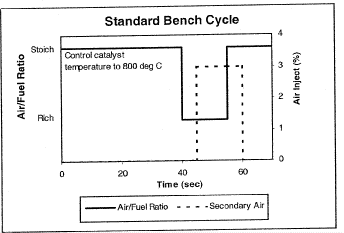Appendix VII to Part 86 - Standard Bench Cycle (SBC)
40:21.0.1.1.5.21.1.12.65 : Appendix VII
Appendix VII to Part 86 - Standard Bench Cycle (SBC)
1. The standard bench aging durability procedures [Ref. §
86.1823-08(d)] consist of aging a catalyst-oxygen-sensor system on
an aging bench which follows the standard bench cycle (SBC)
described in this appendix.
2. The SBC requires use of an aging bench with an engine as the
source of feed gas for the catalyst.
3. The SBC is a 60-second cycle which is repeated as necessary
on the aging bench to conduct aging for the required period of
time. The SBC is defined based on the catalyst temperature, engine
air/fuel (A/F) ratio, and the amount of secondary air injection
which is added in front of the first catalyst.
Catalyst Temperature Control
1. Catalyst temperature shall be measured in the catalyst bed at
the location where the highest temperature occurs in the hottest
catalyst. Alternatively, the feed gas temperature may be measured
and converted to catalyst bed temperature using a linear transform
calculated from correlation data collected on the catalyst design
and aging bench to be used in the aging process.
2. Control the catalyst temperature at stoichiometric operation
(01 to 40 seconds on the cycle) to a minimum of 800 °C (±10 °C) by
selecting the appropriate Engine speed, load, and spark timing for
the engine. Control the maximum catalyst temperature that occurs
during the cycle to 890 °C (±10 °C) by selecting the appropriate
A/F ratio of the engine during the “rich” phase described in the
table below.
3. If a low control temperature other than 800 °C is utilized,
the high control temperature shall be 90 °C higher than the low
control temperature.
Standard Bench Cycle (SBC)
Time
(seconds) |
Engine air/fuel ratio |
Secondary air injection |
| 01-40 |
14.7 (stoichiometric, with
load, spark timing, and engine speed controlled to achieve a
minimum catalyst temperature of 800 °C) |
None |
| 41-45 |
“Rich” (A/F ratio selected to
achieve a maximum catalyst temperature over the entire cycle of 890
°C, or 90° higher than low control temperature) |
None |
| 46-55 |
“Rich” (A/F ratio selected to
achieve a maximum catalyst temperature over the entire cycle of 890
°C, or 90° higher than low control temperature) |
3% (±0.1%) |
| 56-60 |
14.7 (stoichiometric, same
load, spark timing, and engine speed as used in the 01-40 sec
period of the cycle) |
3% (±0.1%) |

[71 FR
2837, Jan. 17, 2006]
 [71 FR
2837, Jan. 17, 2006]
[71 FR
2837, Jan. 17, 2006]